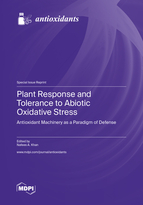Plant Response and Tolerance to Abiotic Oxidative Stress: Antioxidant Machinery as a Paradigm of Defense
A special issue of Antioxidants (ISSN 2076-3921). This special issue belongs to the section "ROS, RNS and RSS".
Deadline for manuscript submissions: closed (30 January 2023) | Viewed by 56313
Special Issue Editor
Interests: plant stress physiology; hormonal; nutrients and abiotic stress cross-talk
Special Issues, Collections and Topics in MDPI journals
Special Issue Information
Dear Colleagues,
Plants, being sessile living organisms, are continuously exposed to a large number of abiotic stress factors during their life cycle that influence their cellular metabolism, physiological processes and growth and development. They have thus evolved inherent strategies to acclimatize to the changing abiotic stress conditions and adapt through in-built tolerance mechanisms. However, drastic changes in climatic conditions further aggravate the stress impact on plants that exceeds the plants’ capacity of their tolerance. Factors such as low or high temperature, drought or waterlogging, high salinity, ultraviolet radiation, heavy metals, nutrient stress, etc. are grouped under abiotic stress which generates excess production of reactive oxygen species (ROS) causing oxidative stress. These ROS, if not scavenged, cause damage of cellular components including lipids, proteins, nucleic acids, metabolites, and is extreme cases even death of cells in plants. Confronted to an abiotic stress, there is an initial elevation of ROS that activates redox signalling to initiate defense in plants through activation of the antioxidant activity. The improvement in the capacity of antioxidant machinery is one of the essential strategies to develop tolerance and relieve the pressure of abiotic stress induced oxidative changes for the survival of plants. This Special Issue welcomes papers pertaining to abiotic stress and antioxidant system so that a collective knowledge is gathered for abiotic stress tolerance mechanisms.
Researchers are welcome to submit significant contributions as research articles/review articles/methods to this Special Issue on the topics listed below, but not limited, to present state-of-the-art on the subject:
- Impact of abiotic stress factors, limitation or excess of nutrients, temperature, flood, metals contamination, drought, and salinity, on physiology/biochemistry and molecular biology of plants
- Response of antioxidant machinery to the changing abiotic stress conditions, and strategies to strengthen the antioxidant machinery for the survival of plants
- Strategies to improve the tolerance mechanisms of plants against abiotic stress factors
- Role and the mechanisms of the plant signaling molecules/growth modifiers /mineral nutrients/hormones/other elicitors in relieving impacts of abiotic stresses
- The utilization of approaches such as genomics, metabolomics, transcriptomics, proteomics, ionomics, and nutiomics to strengthen antioxidant machinery and make plant life easier under the abiotic stress conditions
Prof. Dr. Nafees A. Khan
Guest Editor
Manuscript Submission Information
Manuscripts should be submitted online at www.mdpi.com by registering and logging in to this website. Once you are registered, click here to go to the submission form. Manuscripts can be submitted until the deadline. All submissions that pass pre-check are peer-reviewed. Accepted papers will be published continuously in the journal (as soon as accepted) and will be listed together on the special issue website. Research articles, review articles as well as short communications are invited. For planned papers, a title and short abstract (about 100 words) can be sent to the Editorial Office for announcement on this website.
Submitted manuscripts should not have been published previously, nor be under consideration for publication elsewhere (except conference proceedings papers). All manuscripts are thoroughly refereed through a single-blind peer-review process. A guide for authors and other relevant information for submission of manuscripts is available on the Instructions for Authors page. Antioxidants is an international peer-reviewed open access monthly journal published by MDPI.
Please visit the Instructions for Authors page before submitting a manuscript. The Article Processing Charge (APC) for publication in this open access journal is 2900 CHF (Swiss Francs). Submitted papers should be well formatted and use good English. Authors may use MDPI's English editing service prior to publication or during author revisions.
Keywords
- Antioxidants
- ROS/RNS
- Abiotic stress
- Ascorbate-glutathione
- Signaling
- Oxidative stress
- Detoxification







